The Greatest Loss for Rome? The Win for Hannibal at Cannae
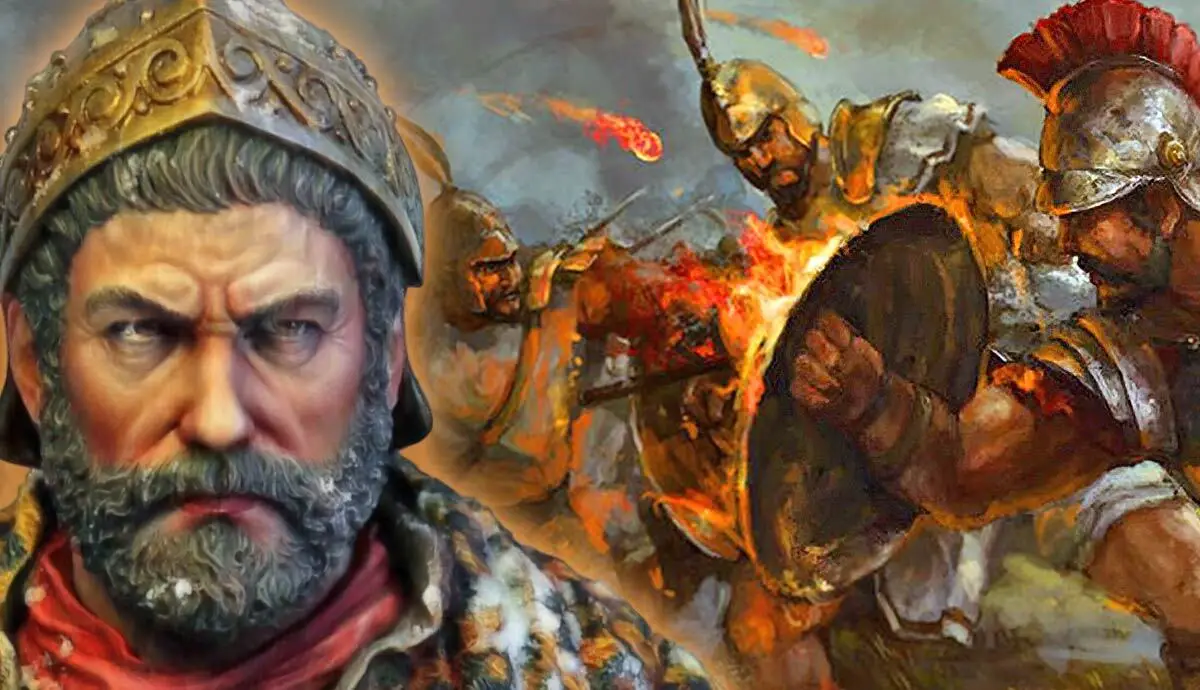
In 216 BCE, Hannibal inflicted one of the most devastating losses in Roman military history at Cannae — but how did his outnumbered forces defeat the Romans on their soil?
In the third century BCE, the Mediterranean was dominated by the powers of Rome and Carthage. These ambitious rivals inevitably came to blows in a series of conflicts called the Punic Wars which would decide which power held hegemony over the Mediterranean for centuries to come. Under the leadership of the formidable Hannibal Barca, Carthage would bring Rome to the brink of destruction, and at no point until the fall of the empire would Rome’s survival hang by so thin a thread as it did with the Battle of Cannae.
The Road to the Battle of Cannae: The Second Punic War
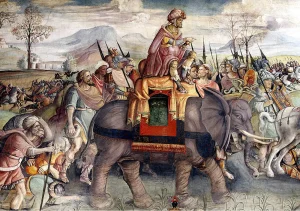
Hannibal in Italy, detail from the fresco in the Hall of Hannibal, Jacopo Ripanda, ca. 1510, Musei Capitolini, Rome
The Second Punic War between 218 and 204 BCE was the most significant of the three Punic Wars. Sparked by Carthaginian advances upon the Roman-allied city of Saguntum in Spain, the conflict became a desperate struggle for the Romans due to the fierce leadership of Hannibal Barca.
Hannibal was the son of Hamilcar Barca who had enjoyed tremendous success in the First Punic War. When the Carthaginian leaders sued for peace at the end of that war, Hamilcar was outraged and swore to take revenge upon Rome. Hannibal inherited both his father’s tactical acumen and his burning hatred for the fledgling Republic.
Two other traits which Hannibal possessed were charisma and daring. Hannibal’s plans were often unorthodox but his men followed him against the odds all the same. It was this combination that allowed Hannibal to famously cross the Alps, war elephants in tow, to surprise the Romans on their land. This bold attack on Italy caught the Romans flat-footed. Hannibal inflicted two devastating defeats on Rome at the River Trebia in 218 BC and on the shores of Lake Trasimene the following year. These early victories proved Hannibal’s strategic capabilities, but he would need more battlefield success to subdue the Romans. Hannibal had to force another confrontation where he could decisively defeat the remaining Roman forces and clear a path to Rome itself.
Hannibal’s Armies
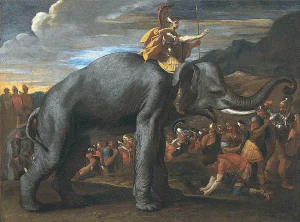
Hannibal Crossing the Alps on an Elephant, by Nicolas Poussin, (1594-1665), via Useum.org
Although famed for his elephants, Hannibal did not use them at Cannae. Most had died crossing the Alps or in the two years since arriving in Italy. Instead, Hannibal’s army was made up of a mix of infantry and cavalry drawn from his own Carthaginian forces and various other allies.
The bulk of Hannibal’s foot soldiers were Carthaginians acting as heavy infantry. Carthage’s military is often described as a mercenary force. It certainly employed a wide range of peoples and was far more diverse than its Roman counterparts, but the lion’s share of their forces would still have been Carthaginian or drawn from any of the numerous cities and towns under its control. Sources indicate that Hannibal outfitted these soldiers with the heavier Roman armor and arms taken in previous victories, nullifying any advantage Rome might have had in the quality of its equipment.
The light infantry was composed mostly of Spaniards and Gauls who had allied themselves with Hannibal. The Spaniards equipped themselves with thrusting swords and short purple tunics that made them easily distinguishable on the battlefield. Meanwhile, the Celts had slashing swords and entered battle naked. Also among his lighter infantry were Balearic Slingers, famed for their ability to launch deadly projectiles at targets at a range without the need for a more cumbersome bow and arrow. In total, Hannibal had about 40,000 infantry.
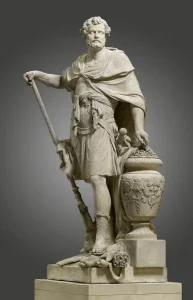
Annibal (Hannibal), by Sébastien Slodtz, 1722, via the Louvre
To understand how Hannibal would achieve this, we must first understand his forces. Hannibal’s ace in the hole was his cavalry. The exact share of his 10,000 mounted units is a matter of debate, but we can distinguish two groups. The first were the allied cavalry from Spain and Gaul, neither of which were especially remarkable. However, the second group was the Numidians. These North Africans were famed for their horsemanship and were arguably the greatest cavalry force in the Mediterranean at the time. Hannibal would use them to tremendous effect in the battle to come.
This formidable mix of infantry and cavalry also possessed the most valuable of military assets: experience. Having defeated the Romans twice in pitched battles and endured countless skirmishes, Hannibal’s armies were battle-hardened, able to handle both the physical and psychological demands of battle. Furthermore, Hannibal’s successful leadership had earned their trust and allowed him to count on their support in the most unorthodox and daring battlefield strategies.
These three advantages of cavalry, experience, and trust would be key to Hannibal’s victory at Cannae.
Rome’s Folly
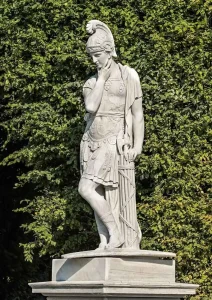
Fabius Cunctator, Joseph Baptist Hagenauer, 1777, via Schönbrunn Palace
In contrast, Rome’s response to its early defeats set the stage for the disaster to come.
After Hannibal’s earlier victories, Rome turned to the emergency office of the dictator to see them through the crisis. Quintus Fabius Maximus was given supreme power for six months but rather than engage Hannibal again, Fabius focused on harassing Hannibal as he moved through Italy. This strategy bought Rome time to raise another army, but many Romans felt that his delaying tactics were frustrating and dishonorable. After Fabius finished his term, Rome expressed its disapproval through the consular elections of 216 BCE by the election of Gaius Terentius Varro.
The consuls were the two leading magistrates of the Roman state and it would fall to them to lead Rome’s war effort against Hannibal. Varro was a fierce critic of Fabius and rejected his delaying strategies in favor of crushing Hannibal outright with Rome’s numerical superiority. Our sources portray him as a brash, overconfident, and foolish leader, contrasted with his co-consul: Lucius Aemiliaus Paulus. Paulus was a veteran commander who emerged from our sources as wise and rightly cautious to engage Hannibal. The contrast between these two men has dominated accounts and explanations of the Roman defeat ever since.
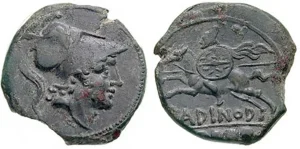
Roman coin showing Minerva or Mars (left) and contemporary Roman cavalry (right), Larinium, 210-175 BCE, via Numista.com
Typically, Roman consuls led their armies separately. Each consul commanded four legions, each of 4,000 men with 200 cavalry, along with several non-Roman allied forces. According to Polybius, in 216 BCE, the two consular armies were combined and expanded to meet the unprecedented threat Hannibal posed. Eight legions would march together, and each of those Legions was expanded to 5,000 men and 300 cavalry. An equal number of infantry and a cavalry regiment twice the size of the Romans’ would be drawn from Rome’s allies. In total, the army assembled to face Hannibal for a third time contained 80,000 infantry and over 7,000 cavalry. This gave them a 2-to-1 infantry advantage against their enemy, although Hannibal maintained cavalry superiority.
However, several critical flaws emerged from this decision. Firstly, Roman law dictated that when two consuls marched together, they each took command on alternate days. This meant that the cautious Paulus would be in charge one day, only for reckless Varro to have total power the next, creating an almost bipolar divide in strategy from day-to-day. The second fatal issue was the quality of the army: a huge number of the soldiers were raw recruits with no battle experience. Against Hannibal’s veteran forces, this inexperience could be disastrous. Their numerical superiority might also have contributed to Varro’s overconfidence, and possibly that of his men too, who expected an easy victory against an army half their size.
Prelude to a Disaster
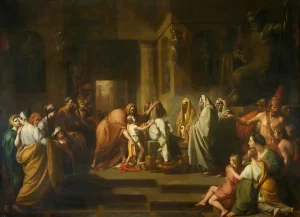
The Oath of Hannibal, by Benjamin West, 1770, via Royal Collection Trust,
In early 216 BCE, the Romans marched to meet Hannibal at Cannae, where disagreements between Varro and Paulus were quickly apparent. Varro ignored Paulus’ warnings about advancing over flat terrain when approaching Cannae — Paulus rightly knew that flat land complemented Hannibal’s cavalry advantage — which resulted in them walking into a small Carthaginian ambush. Although the ambush was repulsed, Varro stumbling into a Carthaginian trap against the advice of his colleague seems almost prophetic. According to Livy, Varro was convinced that Paulus’ cautious advice was only a trick to prevent Varro from attacking Hannibal and winning military glory for himself.
By the time Paulus took command the following day, it was too late to turn back, so he encamped his army on the back of the Aufidus River and sent a smaller detachment across the river to harass Hannibal’s foraging parties. Seeing this, Hannibal drew his army up in battle formation to goad the Romans out, but Paulus refused to meet him. After some light raiding from the Numidians, Hannibal withdrew for the night. Paulus would not be easily lured into a fight. The same could not be said for Varro.
The next day, Paulus handed power back to Varro for the final time. Varro rallied his army early in the morning and marched out to meet Hannibal on the field.
Varro’s battle formation was fairly standard. He placed his infantry in the center, with the lighter hastati in front and the heavier principes behind. Varro ordered his infantry to be laid out deeper rather than wider, concentrating his forces narrowly so that he could use them to smash through the Carthaginian line. Varro himself was with the allied cavalry on the left, while Paulus commanded the Roman cavalry on the right.
Hannibal’s formation appeared to echo Varro’s. He placed his weaker allied cavalry on his left opposite Paulus’ Roman cavalry, under the command of his brother Hasdrubal. His elite Numidians took Hannibal’s right under his other brother Hanno (Polybius) or the Numidian leader Maharbal (Livy), opposite Varro’s allied cavalry. Hannibal’s center was composed of infantry, and it was upon these infantry that Hannibal’s strategy, and the legendary reputation of Cannae, would rest. Hannibal placed his light infantry in the middle, but split his heavier African infantry in half and placed them on either side of the light infantry in between them and the cavalry. The result was a wider line with a weaker center. Hannibal placed himself in that center with his infantry so he could command the most critical part of the battle.
The Battle of Cannae
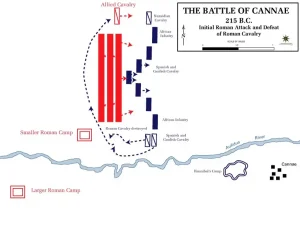
Map of the initial fighting at the Battle of Cannae, via The Department of History, United States Military Academy
Sometime before noon, the battle began. The two armies advanced, but Hannibal’s formation quickly changed. He had his light infantry advance while the heavier infantry on their flanks hung back. He also advanced the very center of his forces faster than those around them. This created a tempting target for the Romans, who concentrated their attack on the protruding center of Hannibal’s advancing line.
Meanwhile, both cavalry wings engaged in a flurry of combat away from the infantry battle. Varro’s more numerous allied cavalry were able to hold their own against the Numidians, but they were gradually drawn away from the main battle as the day progressed. The Romans fared much worse on their right flank, where Paulus’ Roman Cavalry was soon overwhelmed by the enemy. According to Polybius, there was so little space to maneuver in the chaos that riders dismounted their horses to fight man-to-man instead.
Back in the center, Rome’s principes joined the fray as the hastati pulled back. Recognizing the weakness of the Carthaginian center, the narrowly-packed Romans concentrated their effort, probably hoping to split Hannibal’s army right down the middle. Sure enough, the Carthaginian center started to give ground. The inverted crescent became a straight line and then began falling into a regular crescent as Carthage’s lighter troops buckled under the weight of the concentrated Roman attack. However, while Hannibal’s center fell back, it was no rout. Whether due to their own bravery, Hannibal’s reassuring presence, or their utmost faith in his plan, the Carthaginian center kept fighting as the Romans pushed them back.
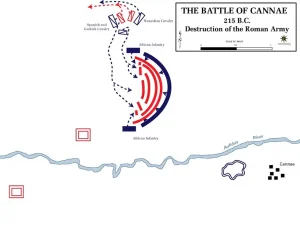
Map of the encirclement of the Roman army at the Battle of Cannae, via The Department of History, United States Military Academy
However, the Romans had made a fatal error. By pushing the Carthaginian center back, they had left the heavier, better-armed African infantry on the wings in place. Furthermore, because of the Roman advance, these African troops were now on the Romans’ flanks. The trap had been sprung. Hannibal gave the order, and the African infantry turned inward to launch a furious assault on the vulnerable Roman flanks.
The battle descended into chaos as the Romans were attacked on three sides. The Numidians had tied down Varro’s cavalry so he could not render aid and Paulus’ cavalry was all but destroyed. Paulus himself rushed to the infantry’s aid, but it was a fruitless effort. Men were packed too tightly together to fight as the Carthaginian forces hemmed them in. The encirclement nullified the Romans’ superior numbers and soon, the surrounded Romans were panicking as they were cut down in the hundreds. Bravery turned to desperation, and the battle became a slaughter.
Livy gives a vivid, albeit probably fictional, account of Paulus’ last stand amid the hopeless struggle. Another officer tried to offer him a horse to escape, but Paulus refused, urging the officer to ride for Rome and warn them about Hannibal’s victory before telling him to “leave me here to breathe my last among my slaughtered soldiers.”
Only a handful of Romans escaped before Hasdrubal’s victorious cavalry arrived. Having driven the Romans from the field, they smashed into the Roman flank and cut off their retreat. There would be no escape for those who remained. Cannae was lost, and 50,000 Roman and allied lives with it.
Hannibal’s Victory
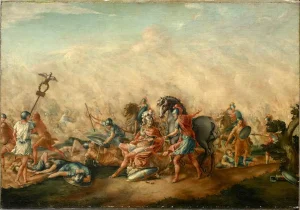
The Death of Paulus Aemilius at the Battle of Cannae, by John Trumbull, 1773, via Yale University Art Gallery
Hannibal had achieved a remarkable feat: the encirclement of a larger army by a smaller one, and his reward was one of the most crushing defeats that Rome ever suffered.
Polybius claims that 57,000 Romans and allies died while Livy places the number slightly over 48,000. About 10,000 men were captured while the rest fled, including Varro himself. Among the dead were several former consuls, including Paulus, twenty-nine tribunes, and at least eighty other men of Senatorial rank or greater, eviscerating Rome’s political, social, and military leadership. Carthage’s death toll was said to be as low as 7,000, although it was probably higher than this.
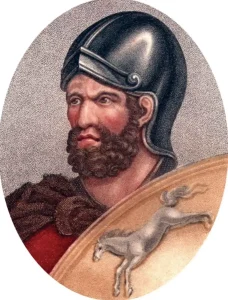
Engraving showing Hannibal, by John Chapman, 1800, via Encyclopedia Britannica
A defeat like Cannae would have broken any other power. Rome’s ability to survive the string of defeats that led to Cannae, let alone to bounce back and ultimately win the war after it, was exceptional. Various explanations have been sought for why: the psychology of the Roman people, the quality of its political system, and Roman military success on the Spanish and later African fronts of the war are all reasonable explanations.
One of the enduring questions is why Hannibal never proceeded to attack Rome after Cannae. Livy famously claims the Numidian Maharbal accused Hannibal of knowing how to win a victory, but not how to use it because of his refusal to attack Rome, but modern historians broadly agree that Hannibal was wise not to attack the city. In truth, Hannibal lacked the necessary siege equipment, while the urban fighting would deny him his cavalry and tactical advantages in favor of brutal street fighting among a resistant populace, many of whom would have been men with military experience.
Cannae fundamentally shifted Rome’s military strategy. Rome avoided any more direct engagements with Hannibal for a decade. Hannibal spent that time traveling around Italy with a slowly dwindling army as Rome turned to Fabius’ harassing tactics once more. Meanwhile, Roman victories in Spain under the young Publius Cornelius Scipio, himself a survivor of Cannae, eventually led to a Roman invasion of North Africa. Hannibal was forced to abandon Italy and was finally defeated by Scipio at the Battle of Zama in 204 BCE. Hannibal survived in exile, briefly fought Rome again under the Seleucid Emperor Antiochus III, and eventually in Bithynia 20 years after the war’s end. Despite his battlefield success, Rome was able to adopt a new strategy — not to fight Hannibal unless they were extremely prepared — and ultimately emerged victorious.
Challenging the Narrative
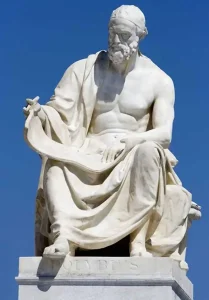
Statue of Polybius at the Austrian Parliament Building, Vienna, by Theophil Hansen, 1874-1883, via EveryPixel
This article mostly followed the traditional narrative and assumptions presented in Polybius and Livy, which have formed the basis of the popular view of the battle. However, there are two critical issues with these accounts that must be addressed before concluding.
The first regards Paulus and Varro. The traditional narrative presents Paulus as a wise, cautious, and honorable Roman hero, while Varro is the impulsive fool who is ultimately responsible for the catastrophe. Both Polybius and Livy clearly follow this line, but we have reason to doubt the characterizations of both men. Firstly, Polybius was writing under the patronage of Paulus’ great-grandson, Scipio Aemilianus. It is reasonable to think that Polybius might have had a motive to paint Paulus in a good light or risk losing his patron. Shifting the blame to Varro made sense since Varro was from a relatively low-born family, making him a preferable scapegoat. Some historians have gone further, suggesting that it was actually Paulus, not Varro, who was in command at Cannae. Although Varro survived, sources tell us that he was well-received upon returning to Rome and was not treated with the same hostility meted out to other Roman commanders for far less devastating defeats. Others have pointed out that all our sources place Paulus on the right wing of the battle, which is traditionally the position of the overall commander of the Roman forces. None of these are definitive but we should be skeptical of the stark caricatures of Varro and Paulus and be cautious before trying to pin the blame for Cannae on either man.
The other question to raise is whether Hannibal’s plan was ever a plan at all. Some historians have suggested that Cannae was not the product of a clever pre-planned strategy from Hannibal but an impromptu response to a changing battlefield. It has been argued that the initial inverted crescent formation occurred because the lighter troops naturally moved faster than the heavier wings, not because Hannibal had planned it so, and the subsequent retreat was a normal response from the lighter infantry falling back under heavier Roman attack.
This interpretation has attracted mixed responses. Polybius insists it was planned, while Livy never voices his opinion, but given Hannibal’s earlier tactical victories at Trebia and Trasimene, along with the difficulty of improvising such a remarkable battlefield feat, it seems more likely that Hannibal had indeed planned effectively. Even if he had not planned it ahead of time, his ability to recognize the opportunity and execute it on the fly would still be an impressive show of generalship.
Battle of Cannae: Conclusion
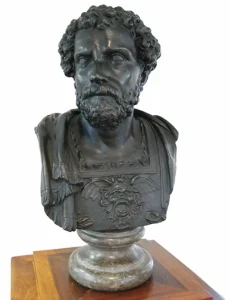
Bust of Hannibal, formerly owned by Napoleon, by François Girardon, ~1700, via University of Saskatchewan
Through this retelling of events, we have assembled a number of reasons to explain how Rome suffered its devastating loss at Cannae. Hannibals’ superior cavalry and experienced troops were obstacles that Rome could not effectively counter and, regardless of whether Paulus and Varro were really the contrasting personalities that our sources claim, it is evident that neither was able to match Hannibals’s tactical skill.
Hannibal managed to exploit all of his advantages to win at Cannae. He deployed his superior cavalry to draw away Varro and seal the trap once Paulus’ cavalry had been defeated. He used the trust he had built with his men to encourage them to follow the risky plan by placing himself in the center to act as a reassuring presence and to best command the most critical part of the field. His tactics neutralized the Romans’ infantry advantage and, if our sources are to be believed, played on the overconfidence and overeagerness of Varro to lure the Romans into his devastating trap. A number of factors did indeed converge to shape the outcome of the Battle of Cannae, but it was undoubtedly Hannibal’s ability to respond to them — to leverage his strengths and exploit his enemy’s weaknesses — that translated those from mere advantages to decisive components of his legendary victory.
From Napoleon to Eisenhower, from Norman Schwarzkopf to Scipio himself, countless military figures after Hannibal have revered him for his strategic brilliance at Cannae and sought to implement his ideas into their own strategy. Having analyzed the battle for ourselves, it is easy to understand why. Hannibal’s generalship earned him a phenomenal victory and handed Rome not just one of its greatest losses, but one of the most enduring stories of military defeat in human history.